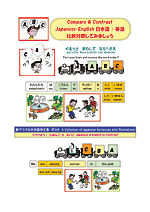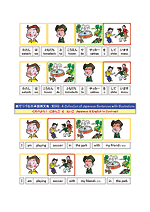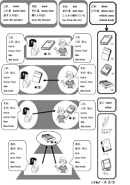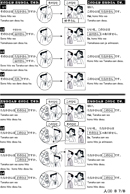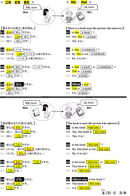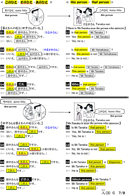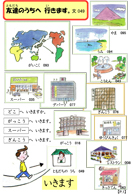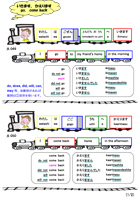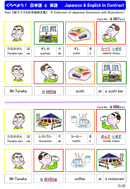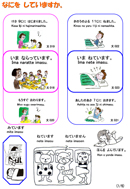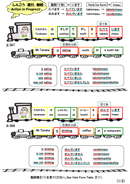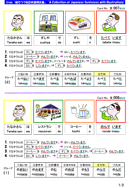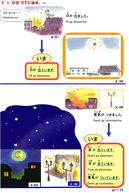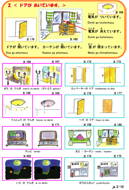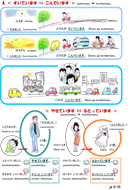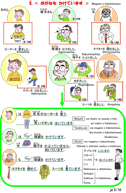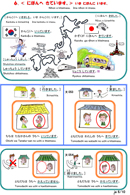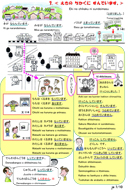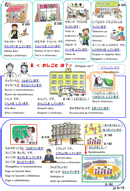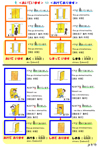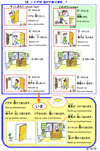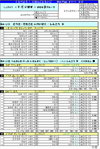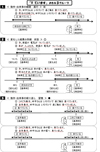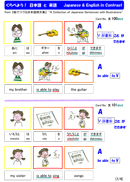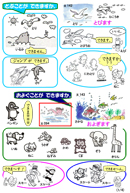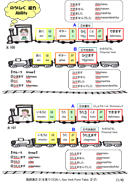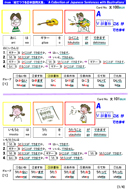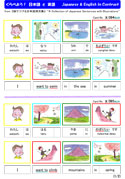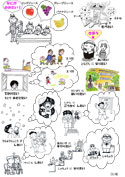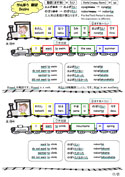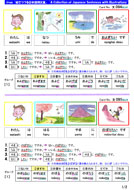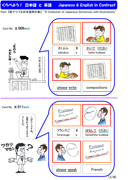
| “A Collection of Japanese Sentences with Illustrations” (a collection of 4-frame picture sentence strips) was constructed for teaching Japanese, but when the strip is reversed, it proved to be useful in teaching English as well. Compare and contrast Japanese and English. It is interesting! These are some parts of materials which are used in teaching / learning Japanese as a foreign language classes at NPO Japanese Language School YUUGOO. Kazumi Yagi
kazm-pic_yagi_@nifty.com “A Collection of Japanese Sentences with Illustrations” is on sale. ISBN978-4-906611-91-1 C3781 (changed in 2008) Coscom Language Service, Inc. |
日本語って? What's Japanese Language?
英語と比較しましょう。 Compare it with English.
|
|
| 1 | 20 sentences 10 pages |
| 【Jap】 ① asa / terebi o / mimasu ② 8ji ni / asagohan o / tabemasu ③
kaisha de / furansugo o / hanashimasu 【Eng】 ① watch / TV / in the morning ② eat / breakfast / at eight ③ speak / French / at the office |
| 2 | 22 sentences 22 pages |
| ① Asa terebi o mimasu ka. → Hai, mimasu. ② Yoru terebi o mimasu ka.
→ Iie, mimasen. 【Yes/No Question】 ③ Terebi o asa mimasuka, yoru mimasu ka. → Asa mimasu. 【A or B Question】 ④ Itsu terebi o mimasuka. → Asa mimasu. 【WH Question】 |
| 3 | 22 sentences 22 pages |
| ① Do you watch TV in the morning? → Yes, I do. ② Do you watch TV
at night? → No, I don't. 【Yes/No Question】 ③ Do you watch TV in the morning or at night? → I watch it in the morning. 【A or B Question】 ④ When do you watch TV? → I watch it in the morning. 【WH Question】 |
| 4 | 38 sentences 20 pages |
| ① Asa 7ji ni okite, kao o aratte, ha o migaite, 8ji ni asagohan o tabemasu.【Succession】 ② 6ji ni bangohan o tabete, rajio o kiite, ofuro ni haitte, 11ji ni nemasu.【Succession】 ③ Asa terebi o mite, yoru rajio o kikimasu. ④ Asa shawaa o abite, yoru ofuro ni hairimasu.【Contrast】 |
1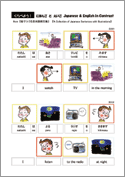 2 2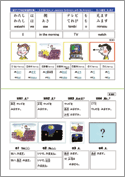 3 3 4 4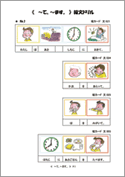 |
| 5 | Drills 『4 Ouestions & Answers』 78 sentences 42 pages |
| A:≪Kore wa hon desu.≫ B:≪Hon wa kore desu.≫ C:≪Kore ga hon desu.≫ Make the points clear with 『4 Ouestions & Answers』. A: ① Sore wa hon desu ka. → Hai, hon desu. ② Sore wa nooto desu ka. → Iie, nooto ja arimasen. ③ Sore wa hon desu ka, nooto desu ka. → Hon desu. ④ Sore wa nan desu ka. → Hon desu. B: ① Hon wa sore desu ka. → Hai, kore desu. ② Hon wa kore desu ka. → Iie, sore ja arimasen. ③ Hon wa sore desu ka, kore desu ka. → Kore desu. ④ Hon wa dore desu ka. → Kore desu. C: ① Sore ga hon desu ka. → Hai, kore ga hon desu. ② Kore ga hon desu ka. → Iie, sore wa hon ja arimasen. ③ Sore ga hon desu ka, kore ga hon desu ka. → Kore ga hon desu. ④ Dore ga hon desu ka. → Kore ga hon desu. pp1-8 【Noun Predicate Sentences*】 pp9-11 【Adjective Pred. Sent*】⇔【Noun Pred. Sent.*】 pp12-39 【Verb Pred. Sent.*】 * Sentence which ends with Noun ……… Kore wa omoshiroi hon desu /omoshiroi hon ja arimasen. * Sentence which ends with Adjective … Kono hon wa omoshiroi desu / omoshirokunai desu. * Sentence which ends with Verb ……… Watashi wa hon o yomimasu / yomimasen. |
| 6 | 6頁 ※Cover or hide letters below the pictures. Reffer to ≪Effective ways to keep 200 picture cards together≫ 【2】 Rapid Practice |
| ① Asa ■ terebi ■ mimasu. ③ 8ji ■ asagohan ■ tabemasu. ⑦ Sushiya ■ sushi ■ tabemasu. ② Yoru ■ rajio ■ ( ). ④ 6ji ■ bangohan ■ ( ). ⑧ Resutoran ■ koohii ■ ( ). |
| 7 | 『A Collection of Japanese Sentences with Illustrations』 Contents Basic Japanese example sentences, which focus on sentence structure |
| Japanese - 200 sentences 6 pages |
|
| 文001-012【Place(Action)】de 文013-014【Person】to(isshoni) 文015-018【Person】ni ⇔【Person】kara 文019-027【…o'clok】ni 【…o'clok】kara【…o'clok】made 文028-040【ryoori】o【shimasu】⇔【sakana】o【ryoori shimasu】 文049-054【Place(Direction)】e 【Place(Starting Point)】o 【Place(Arrival Point)】ni 文074-089【Place(Existence)】ni 文134-143【Place(Passing Point)】o 文122-133【Tool / Means】de 文144-155【Putting on or Taking off Clothes】 |
| English - 200 sentences 10 pages |
| 8 |
|
5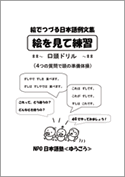 6 6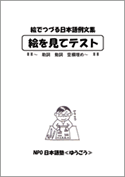 7 7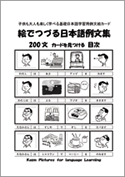 8 8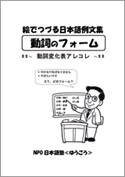 |
|
|
|
||||||||||||||||||||||||||||||||||||||||||||||||||||||||||||||||||||||||||||||||||||||||||||||||||||||||||||||||||||
|
||||||||||||||||||||||||||||||||||||||||||||||||||||||||||||||||||||||||||||||||||||||||||||||||||||||||||||||||||||
|
||||||||||||||||||||||||||||||||||||||||||||||||||||||||||||||||||||||||||||||||||||||||||||||||||||||||||||||||||||
|
 |
Copyright (C) 2016 Kazumi Yagi. All Rights Reserved.
